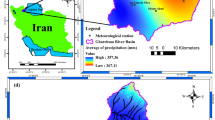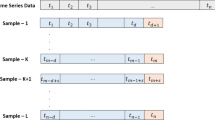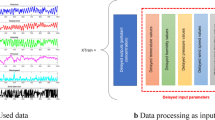Abstract
A Back-Propagation Neural Network (BPNN) was established to predict the daytime variations of HO2 radical concentration observed in the field campaign RISFEX 2003 (RIShiri Fall Experiment 2003) conducted in September 2003 at Rishiri Island (45.07 N, 141.12 E, and 35m asl) in the Sea of Japan. The initial weight matrices and bias vectors for the network were optimized by a bee evolutionary genetic algorithm (BEGA). It was found that the input variables sensitive to HO2 variation were photolysis frequency of O3 to O(1D) (J(O1D)), a composite parameter defined as the ratio of HC to NO x reactivity towards OH radicals (Φ), and the total aerosol surface area (A). The predicted results are closely correlated with the experimental data with the coefficient of determination (R 2) close to 1. In addition, the means and ranges of the predicted HO2 concentration agree with the observed data with the correlation coefficient (R), the index of agreement (IA) and the fractional bias (FB) in the range of 0.84–0.93, 0.88–0.95 and −14%–7%, respectively. This study demonstrates that BPNN is a potential tool to predict the daytime variations of HO2 radical concentrations in the marine boundary layer (MBL).
Similar content being viewed by others
References
George LA, Hard TM, O’Brien RJ. Measurement of free radicals OH and HO2 in Los Angeles smog. J Geophys Res, 1999, 104: 11643–11655
Cantrell CA, Shetter RE, Calvert JG, Eisele FL, Williams E, Baumann K, Brune WH, Stevens PS. Peroxy radicals from photostationary state deviation and steady state calculations during the tropospheric OH photochemistry experiment at Idaho Hill, Colorado, 1993. J Geophys Res, 1997, 102: 6369–6378
Carslaw N, Creasey DJ, Heard DE, Jacobs PJ, Lee JD, Lewis AC, Mcquaid JB, Pilling MJ. Eastern Atlantic Spring Experiment 1997 (EASE97) 2. Comparisons of model concentrations of OH, HO2 and RO2 with measurements. J Geophys Res, 2002, 107, 4190, doi: 10.1029/2001JD000892
Konrad S, Schmitz T, Buers HJ, Houben N, Mannschreck K, Mihelcic D, Musgen P, Patz HW, Holland F, Hofzumahaus A, Schafer HJ, Schroder S, Volz-Thomsa A, Bachmann K, Schlomski S, Moortgat G, Grobmann D. Hydrocarbon measurements at Pabst-thum during the BERLIOZ campaign and modeling of free radicals. J Geophys Res, 2003, 108, 8251, doi: 10.1029/2001JD000866
Ren X, Brune WH, Cantrell CA, Edwards GD, Shirley T, Martinez M, Lesher RL. Hydroxyl and peroxy radical chemistry in a rural area of central Pennsylvania: Observations and model comparisons. Atmos Environ, 2005, 52: 231–257
Gardner MW, Dorling SR. Artificial neural networks (the multilayer perception)-a review of applications in the atmospheric sciences. Atmos Environ, 1998, 32: 2627–2636
Boznar M, Lesjak M, Mlakar P. A neural network-based method for the short-term predictions of ambient SO2 concentrations in highly polluted industrial areas of complex terrain. Atmos Environ, 1993, 27: 221–230
Yi J, Prybutok R. A neural network model forecasting for prediction of daily maximum ozone concentration in an industrialized urban area. Environ Pollut, 1996, 92: 349–357
Moseholm L, Silva J, Larson T. Forecasting carbon monoxide concentrations near a sheltered intersection using video traffic surveillance and neural networks. Transportation Res, 1996, 1D: 15–28
Hooyberghsa J, Mensinka C, Dumontb G, Fierensb F, Brasseur O. A neural network forecast for daily average PM10 concentrations in Belgium. Atmos Environ, 2005, 39: 3279–3289
Grivas G, Chaloulakou A. Artificial neural network models for prediction of PM10 hourly concentrations, in the Greater Area of Athens, Greece. Atmos Environ, 2006, 40: 1216–1229
Kukkonena J, Partanena L, Karppinena A, Ruuskanenb J, Junninenb H, Kolehmainenb M, Niskab H, Dorlingc S, Chattertonc T, Foxalld R, Cawleyd G. Extensive evaluation of neural network models for the prediction of NO2 and PM10 concentrations, compared with a deterministic modelling system and measurements in central Helsinki. Atmos Environ, 2003, 37: 4539–4550
Tanimoto H, Kajii Y, Hirokawa J, Akimoto H, Minko N P. The atmos-pheric impact of boreal forest fires in far eastern Siberia on the seasonal variation of carbon monoxide: Observations at Rishiri, a northern remote island in Japan. Geophys Res Lett, 2000, 27: 4073–4076
Kanaya Y, Sadanaga Y, Hirokawa J, Kajii Y, Akimoto H. Development of a ground-based LIF instrument for measuring tropospheric HOx radi-cals: Instrumentation and calibrations. J Atmos Chem, 2001, 38: 73–110
Qi B, Kanaya Y, Takami A, Hatakeyama S, Kato S, Sadanaga Y, Tanimoto H, Kajii Y. Diurnal peroxy radical chemistry at a remote coastal site over the sea of Japan. J Geophys Res, 2007, 112: D17306, doi:10.1029/2006JD008236
Burkert J, Hernmandez MD, Stobener D, Burrows JP, Weissenmayer M, Kraus A. Peroxy radical and related trace gas measurements in the boundary layer above the Atlantic Ocean. J Geophys Res, 2001, 106: 5457–5477
Carpenter LJ, Monks PS, Galbally IE, Meyer CP, Bandy BJ, Penkett SA. A study of peroxy radicals and ozone photochemistry at coastal sites in the Northern and Southern Hemisphere. J Geophys Res, 1997, 102: 25417–25427
Meng W, Han XD, Hong BR. Bee evolutionary genetic algorithm. Acta Electronica Sinica, 2006, 34: 1294–1300
Peng DG, Wu YG, Jiao HF, Cao H, Zhang L, Zheng XP, Fu LX. Applications of a new genetic and simplex algorithm in optical film design and optimization. Opto-electronic Engineer, 2008, 25: 49–55
Kanaya Y, Matsumoto J, Akimoto H. Photochemical ozone production at a subtropical island of Okinawa, Japan: Implications from simultaneous observations of HO2 radical and NOx. J Geophys Res, 2002, 107: D19, doi: 10.1029/2001JD000858
Sommariva R, Pilling MJ, Bloss WJ, Heard DE, Lee JD, Fleming ZL, Monks PS, Plane JMC, Saiz-Lopez A, Ball SM, Bitter M, Jones RL, Brough N, Penkett SA, Hopkins JR, Lewis AC, Read KA. Night-time radical chemistry during the NAMBLEX campaign. Atmos Chem Phys, 2007, 7: 587–598
Luhar A, Patil RS. A general finite line source model for vehicular pollution dispersion. Atmos Environ, 1989, 23: 555–562
Willmott C. On the validation of models. Phys Geography, 1981, 2: 183–194
Rao ST, Sistila G, Pagnotti V, Peterson WB, Irwin JS, Turner DB. Evaluation of the performance of RAM with the regional air pollution study data base. Atmos Environ, 1985, 19: 229–245
Author information
Authors and Affiliations
Corresponding author
Rights and permissions
About this article
Cite this article
Wang, Z., YaShao, C., Qi, B. et al. Prediction of daytime variations of HO2 radical concentrations in the marine boundary layer using BP network. Sci. China Chem. 53, 2616–2621 (2010). https://doi.org/10.1007/s11426-010-4131-8
Received:
Accepted:
Published:
Issue Date:
DOI: https://doi.org/10.1007/s11426-010-4131-8




